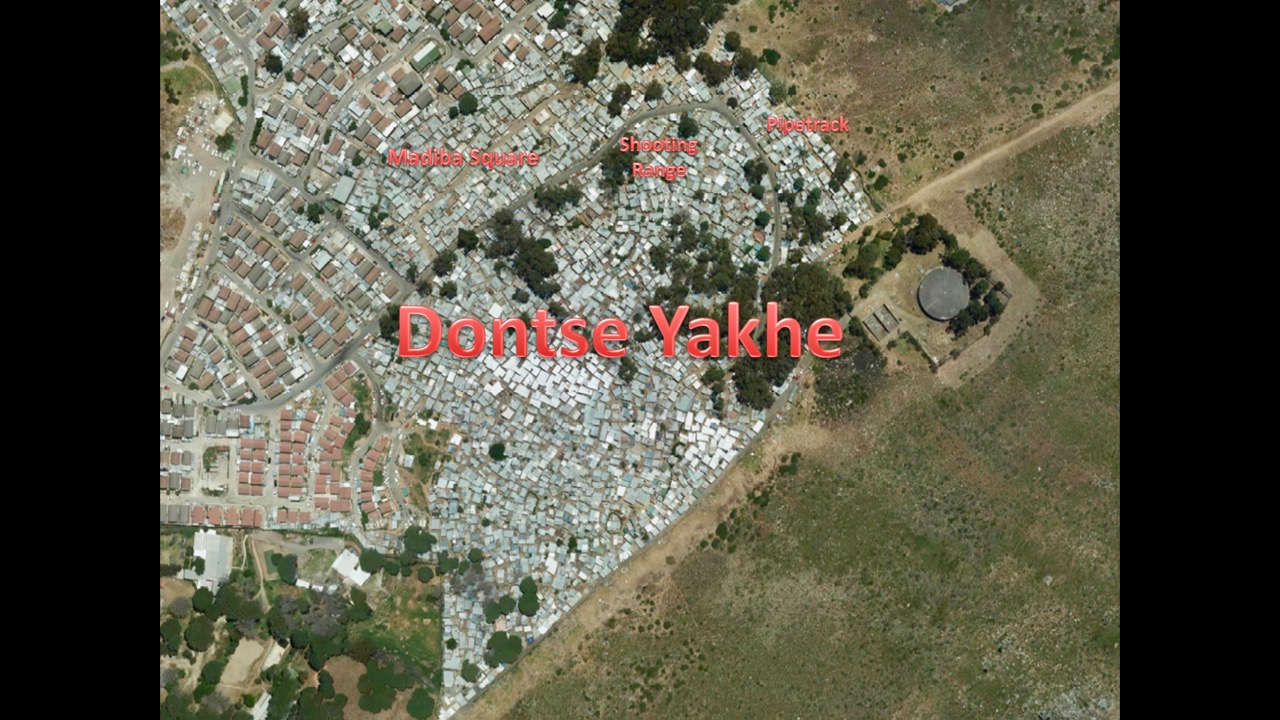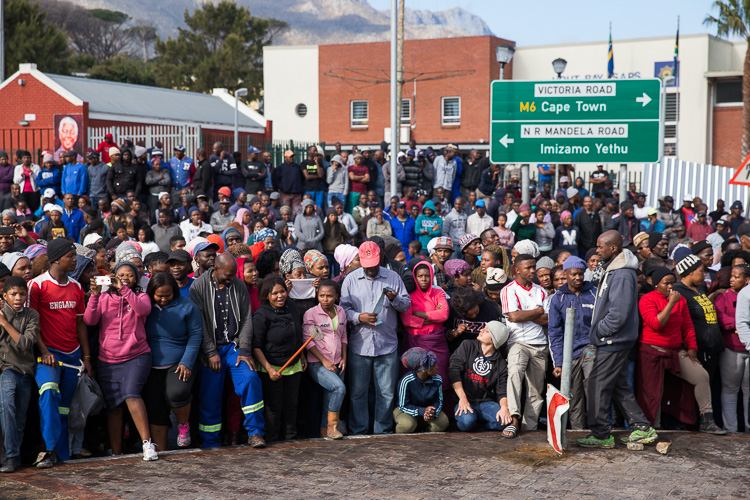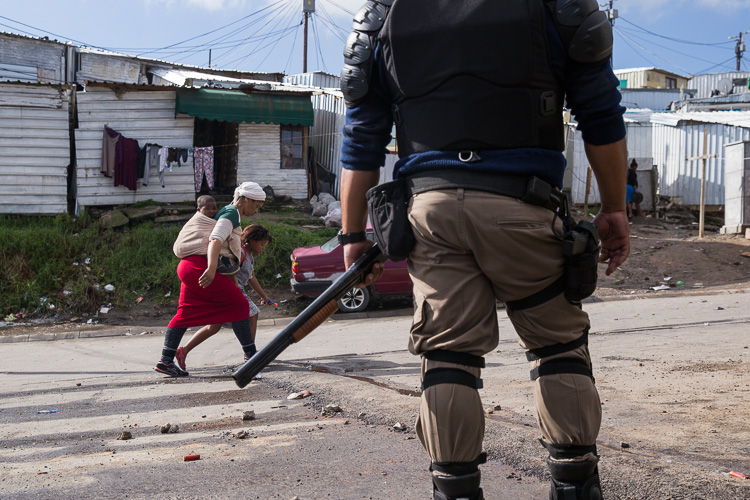Why did Hout Bay explode?
Imizamo Yethu is an example of the complexity of upgrading informal settlements
In the first days of July, Hout Bay was at times cut off from Cape Town when hundreds of residents of the Imizamo Yethu informal settlement cut down trees and barricaded roads leading into the suburb. Police and residents fought with each other. One man, Songezo Ndude, was shot dead. The protesters had been living in temporary accommodation on a sports field. We look at what caused this.
On 11 March a devastating fire in Imizamo Yethu left several thousand people homeless. It was one of the worst shack fires in recent history in the Western Cape, but it was neither the first nor the last in Hout Bay.
Fire is a constant risk in Imizamo Yethu. It spreads rapidly because homes are built close together, often less than one metre apart. Fires are common where residents do not have electricity and therefore use paraffin, candles and open flames, or where electrical connections are illegal and unsafe. It is often impossible for emergency vehicles to get to positions where they can douse fires.
Reblocking
Other than providing formal brick housing, another solution the City proposes is “reblocking” (explained here) – creating a formal layout on an informal settlement with spaced plots, services, access roads and pathways. The City has done this successfully before but it isn’t easy, and each informal settlement presents unique challenges.
After the fire, the City announced plans to “superblock” Imizamo Yethu. It committed over R90 million to the project and an additional R44 million for electrification. The problem was that for reblocking to take place, people who had lost their homes would have to wait longer before they could rebuild their shacks.
In April, Mayor Patricia de Lille announced that the community had agreed to the plans. She said at a press conference held with community leaders that reblocking would be done in three months. But even as she said it, some residents had already begun rebuilding their shacks, making it impossible to proceed with reblocking.

Temporary accommodation
From the outset there were mixed reactions to the City’s plans. Many residents supported reblocking, but others faced difficulties while reblocking took place. Victims of the fire were moved to temporary relocation areas – accommodated in tents, two marquees, community halls and other temporary structures.
Some people refused to be moved to these places, which they found crowded and uncomfortable. They chose instead to find shelter on the mountain or rebuild their shacks.
After the April press conference, people were moved out of the marquees and into temporary one-room, three-by-three-metre shacks on a sports field. Many of them were renting shacks, and they were now registered with the City to get shacks of their own.
On top of this, many residents do not trust the City to reblock in an acceptable timeframe. Community leaders say people who were moved to community halls after a fire in 2004 spent a year there before they gave up on being resettled, and rebuilt their shacks. GroundUp spoke to a resident who was moved to make way for roads in 2007. He says he and his family were moved to a temporary home and told it would be for only three months, then later told six months. They have never been relocated.

Rebuilding, demolitions and interdicts
In the first days after the fire on 11 March, some shack owners started to rebuild. The City immediately responded with demolitions. On 19 March the City obtained a court interdict against people rebuilding their shacks. Residents continued rebuilding nonetheless. Members of the community did not in the end oppose the interdict, and it became a final order of the High Court on 1 June.
The City did not enforce the interdict while it was engaging with the community.
Some residents did agree to stop rebuilding and kept to this. However, in Madiba Square area of Imizamo Yethu, there were some demolitions with voluntary dismantling in late March. Part of this area was then reblocked.
Others however wanted the City to present clear plans on paper with timeframes and a memorandum of agreement. These were not forthcoming and so they rebuilt. By the end of May, the area for reblocking was almost completely filled with shacks.
Differences
Divisions in the community for and against the reblocking, but more specifically on how it is to be implemented continue.
Immigrants who live in the settlement were also wary of how they might be treated in the City’s formal process.
Many of the people displaced by the fire are already listed as beneficiaries for the Imizamo Yethu housing development project. Some of them have large shacks and rent out space or rooms in their shacks. Beneficiaries of the housing project want it completed before reblocking takes place. Then, when they are moved to their RDP houses, they will give up their shacks.
The people who have been renting from them will then be resettled in the informal settlement, but this time with it having been reblocked. This latter group (who rent shacks) appears to make up most of the people who have remained in temporary houses provided by the City, and not rebuilt.

Protests erupt in July
Since the City obtained its interdict on 19 March and the mayor announced reblocking on 13 April, only a small section of Madiba Square has been reblocked.
Many people expected the City to act on the interdict and commence demolitions after 1 June, but the City did not act.
Frustration over delays in reblocking and anger about the absence of a memorandum of agreement with the City bubbled over in July. Protesters said they were tired of having to live in temporary shelters with seemingly no end in sight. They had also had to endure an awful Cape Town storm while in the temporary shacks. They took to the streets in violent protests.
The Mayor then recommitted the City to accelerating reblocking.
But to do this, the City will have to relocate or persuade over a thousand people who have signed a petition against being moved, and remove or demolish the hundreds of homes that have already been rebuilt.
A showdown is looming. Zara Nicholson, spokesperson for the mayor, says: “It has become necessary to enforce the … interdict due to the intimidation, threatening, harassing and assaulting of persons on site working on the super-blocking … There has been and will be further engagement with affected persons. If engagement fails, we will proceed with an eviction application.”
The City has made mistakes in the reblocking process. Residents remember unfulfilled promises. But the multitude of un-nuanced tweets and Facebook comments condemning either the City or the protesters show a lack of understanding of how complex and frustrating the situation is for all involved.

Support independent journalism
Donate using Payfast

Don't miss out on the latest news
We respect your privacy, and promise we won't spam you.
Letters
Dear Editor
Congratulations on a well researched and informative report on the situation in Hout Bay. For once we were not served up the usual "angry residents say" or "angry leaders say" etc etc. Doing it that way is lazy journalism.
This time you have got it just right. Which makes me wonder why there is no byline?
I am now looking forward to a similar report on Masiphumelele because until now all I have seen are reports quoting the usual "angry residents" or "activists" (who need these reports to send to their donors). And please, Groundup, do tell us about the "slum lords" who are very involved in renting out land which does not belong to them.
Thanks again, Groundup. I'll be reading you with great interest. You have set a high bar with the Hout Bay report. This is the way to serve your readers and all the downtrodden folks out there.
Dear Editor
Your paragraph "Fire is a constant risk in Imizamo Yethu" refers.
There were a number of callers into a radio talk show on the morning after it started that claimed to have witnessed this particular fire being started deliberately by a group of men during a gale force wind.
Did you investigate these assertions?
Dear Editor
In 1994 we had an opportunity to reconstitute South Africa, redefine society and build a better future. Sadly almost 25 years later South African towns still have an uptown, middletown and downtown. Separate 'communities' based on race, black, white and coloured.
Hout Bay is one example where coloured, white and black people live in geographically separate areas and in those 25 years very little if anything has been achieved to change that.
The economic divides, like the geographic ones, are as stark but perhaps we miss the economic links and therefore the threads that bind people together. People forget that both rates and tax payers fund the base from which social development should evolve and from which decent and dignified society should emerge but doesn't! That role falls firmly in the hands of government which has indisputably, failed! It's even more sad therefore that those prejudiced by the failure take their frustrations out on the very people that provide the funds that could provide salvation!
Government has failed because it has no vision for society! Houses and in this case 'shacks' do not address the complex needs and solutions of a community and will therefore never create or sustain a healthy social environment. Many of the ills of poor health, violence, mental illness etc. result directly from poor structure in the built environment, tuberculosis and the scourge of rape and interpersonal injury are good examples.
The solution is therefore the construction of an integrated built environment that addresses the diverse needs of a community across a scope of domains including economics, health, employment, education, transport etc.
We are interdependent and whats good for one is good for all! What we really need is for the government (at all levels) to stop its cheap politics and do the right thing, it has the money to do it with, our money after all!
Dear Editor
If government would be as zealous to have homes built according to building regulations, (for example, no homes to be built in flood areas and where firewalls are compulsory, etc., as in South African white suburbs all over South Africa, then there would not be any trouble with fires.
South African Government should be as protective towards township residents' homes as much as it is concerned about suburban homes.
Over crowding of citizens in small areas should be avoided from the beginning since 1994.
I always wonder why township people are exposed to danger without questions asked by their political leaders.. Could it be that they are afraid to lose their voters?
© 2017 GroundUp. 
This article is licensed under a Creative Commons Attribution-NoDerivatives 4.0 International License.
You may republish this article, so long as you credit the authors and GroundUp, and do not change the text. Please include a link back to the original article.

